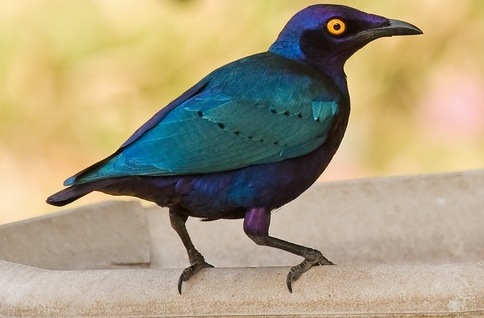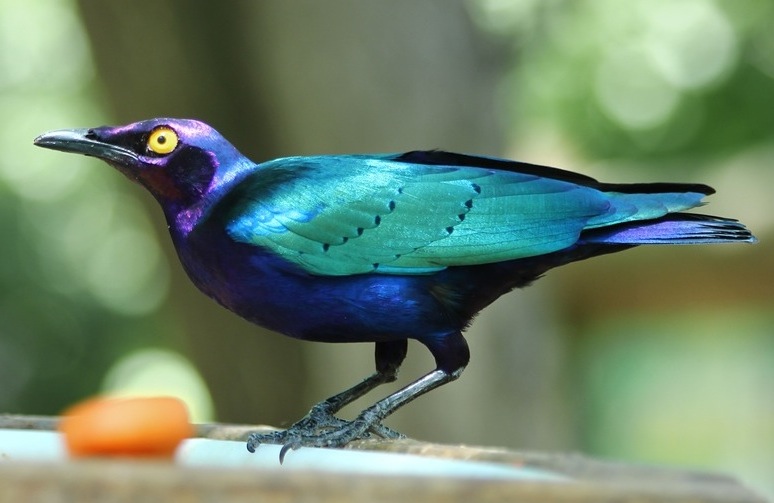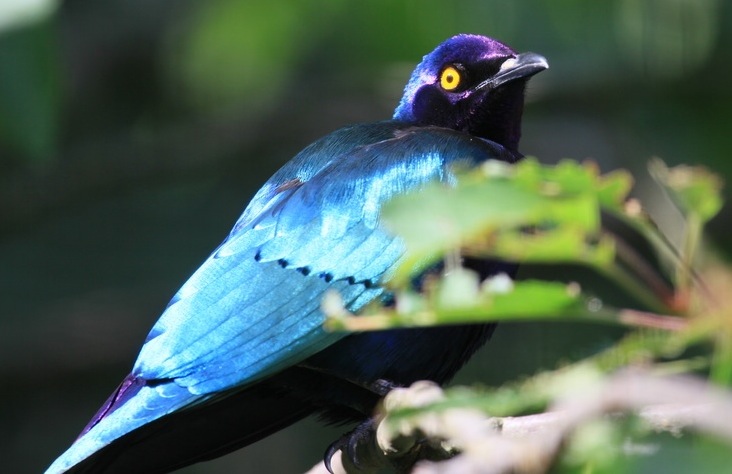Purple glossy starling - Lamprotornis purpureus

Origins: Across much of Africa, south of the Sahara.
Length: 23cm (9in).
Appearance: Distinctive violet-purple colouration on the head and underparts, with the wings and back being shades of iridescent green and blue. The sheen on the plumage is especially stunning when seen in sunlight. Characteristic short tail and bright yellow eyes. Visual sexing is not possible.
Similar species: The purple-headed glossy starling (L. purpureiceps), distinguishable by its purple head and brownish eyes. Also the green glossy starling (L. chalybaeus), which is predominantly green in colour.
Noise rating: Unlikely to worry any neighbours.
Destructive capabilities: Will not damage the structure of the aviary, but may sometimes pull off leaves from plants in the aviary for use as nesting material.
Suitability: Mainly regarded as a colourful and attractive aviary occupant, although young, hand-reared birds could develop into lively pets and might even be taught to say a few words.

Care: Easy to look after, in spite of its highly exotic appearance, and probably one of the most underestimated of all softbills. Can agree in small groups in spacious aviaries, and may be housed even with related species, but pairs are best kept on their own for breeding purposes.
Avoid keeping these starlings alongside finches or other small birds however, because not only may they be persecuted, but their nests are likely to be raided. Simple to feed on a standard softbill diet, comprised of mixed, diced fruit, well-laced with a quality softbill food, and a generous daily helping of mealworms, waxmoth larvae or similar livefoods.
Food must be provided fresh each day. If housed indoors, a large ceramic dish of clean water should be offered two or three times a week for bathing purposes, in order to maintain the condition of the plumage. Hardy once acclimatised, but these starlings should always have a well-lit snug shelter forming part of their aviary, where they can be confined in spells of severe weather.
Breeding: DNA sexing will be necessary to identify a pair with certainty. Provide a nest box for breeding purposes, in the form of a 12in (30cm) cube, with a reasonably broad entrance hole and an access perch beneath. Suitable nesting material in the form of small twigs and leaves will be needed.
Position the nest box under cover - it may be better to provide a choice of sites at first, although this will mean investing in a second nest box. Plenty of small livefood is essential if the chicks are to be reared successfully. Avoid nest inspection unless you suspect that something is wrong, as pairs can be nervous when breeding, and could abandon the nest.

Breeding data: 3-5 eggs. Incubation lasts 14 days. Young fledge from about three weeks onwards. Two broods may be reared in succession over the summer period.
Colour variants: None recorded.
Health concerns: Can be infected with gapeworm, spread by eating livefood contaminated with this parasite. Noisy breathing, with the bill being held slightly open are typical symptoms. Handle a starling very carefully if these parasites are suspected, because they congregate at the top of the windpipe, causing a partial blockage here. Effective treatment is possible - obtain medication from your vet.
Potential lifespan: 8-10 years.
Another option? See a profile of the spreo (superb) starling.
*Also, if you're interested in starlings in general, click here.